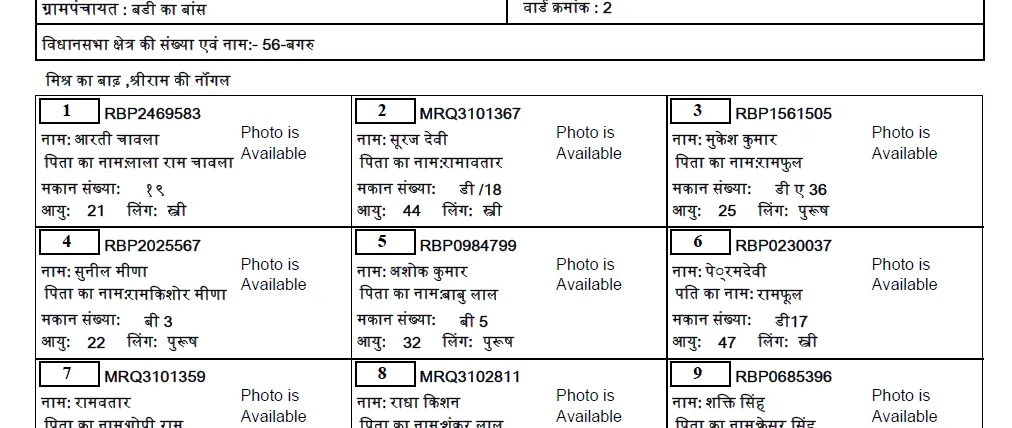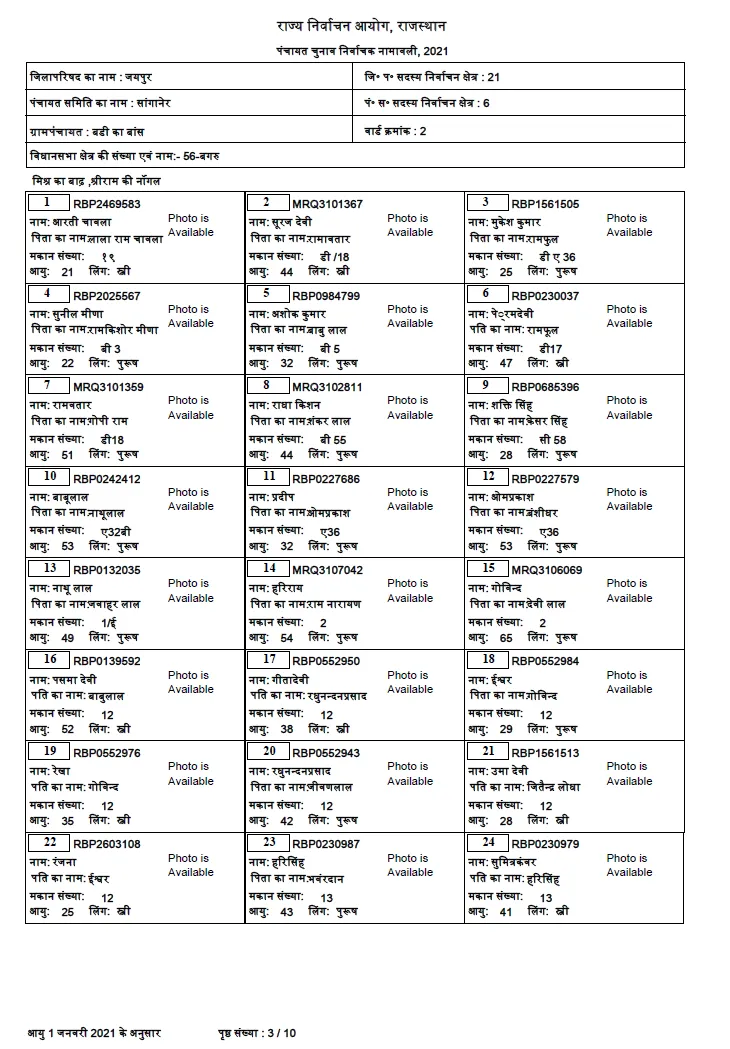我将提供一些关于如何处理您的图像的想法,但我将限制在给定文档的第3页上,即问题中显示的页面。
为了将PDF页面转换为图像,我使用了pdf2image。
对于OCR,我使用pytesseract,但是我使用lang='Devanagari'而不是lang='hin',请参见Tesseract GitHub。通常,请确保通过Tesseract文档中的Improving the quality of the output,特别是page segmentation method来提高输出质量。
以下是整个过程(详细)的描述:
- 将图像反二值化以查找轮廓:黑色背景上的白色文本、形状等。
- 查找所有轮廓,并过滤掉两个非常大的轮廓,即这两个轮廓是两个表格。
- 提取两个表格外的文本:
- 在二值化图像中遮蔽掉表格。
- 进行形态学闭合以连接剩余的文本行。
- 查找这些文本行的轮廓和边界矩形。
- 运行
pytesseract来提取文本。
- 提取两个表格内的文本:
- 从当前表格中提取单元格,更好的方法是提取其边界矩形。
- 对于第一个表格:
- 直接使用
pytesseract提取文本。
- 对于第二个表格:
- 填充数字周围的矩形以防止错误的OCR输出。
- 遮蔽左(印地语)和右(英语)部分。
- 对左侧使用
lang='Devaganari',对右侧使用lang='eng'运行pytesseract,以提高两者的OCR质量。
这就是整个代码:
import cv2
import numpy as np
import pdf2image
import pytesseract
page_3 = np.array(pdf2image.convert_from_path('BADI KA BANS-Ward No-002.pdf',
first_page=3, last_page=3,
dpi=300, grayscale=True)[0])
thr = cv2.threshold(page_3, 128, 255, cv2.THRESH_BINARY_INV)[1]
cnts = cv2.findContours(thr, cv2.RETR_EXTERNAL, cv2.CHAIN_APPROX_NONE)
cnts = cnts[0] if len(cnts) == 2 else cnts[1]
cnts_tables = [cnt for cnt in cnts if cv2.contourArea(cnt) > 10000]
no_tables = cv2.drawContours(thr.copy(), cnts_tables, -1, 0, cv2.FILLED)
no_tables = cv2.morphologyEx(no_tables, cv2.MORPH_CLOSE, np.full((21, 51), 255))
cnts = cv2.findContours(no_tables, cv2.RETR_EXTERNAL, cv2.CHAIN_APPROX_NONE)
cnts = cnts[0] if len(cnts) == 2 else cnts[1]
rects = sorted([cv2.boundingRect(cnt) for cnt in cnts], key=lambda r: r[1])
print('\nExtract texts outside of the two tables\n')
for (x, y, w, h) in rects:
text = pytesseract.image_to_string(page_3[y:y+h, x:x+w],
config='--psm 6', lang='Devanagari')
text = text.replace('\n', '').replace('\f', '')
print('x: {}, y: {}, text: {}'.format(x, y, text))
rects = sorted([cv2.boundingRect(cnt) for cnt in cnts_tables],
key=lambda r: r[1])
for i_r, (x, y, w, h) in enumerate(rects, start=1):
cnts = cv2.findContours(page_3[y+2:y+h-2, x+2:x+w-2],
cv2.RETR_EXTERNAL, cv2.CHAIN_APPROX_NONE)
cnts = cnts[0] if len(cnts) == 2 else cnts[1]
inner_rects = sorted([cv2.boundingRect(cnt) for cnt in cnts],
key=lambda r: (r[1], r[0]))
print('\nExtract texts inside table {}\n'.format(i_r))
for (xx, yy, ww, hh) in inner_rects:
xx += x
yy += y
cell = page_3[yy+2:yy+hh-2, xx+2:xx+ww-2]
if i_r == 1:
text = pytesseract.image_to_string(cell, config='--psm 6',
lang='Devanagari')
text = text.replace('\n', '').replace('\f', '')
print('x: {}, y: {}, text: {}'.format(xx, yy, text))
if i_r == 2:
ys, xs = np.min(np.argwhere(cell == 0), axis=0)
temp = cv2.floodFill(cell.copy(), None, (xs, ys), 255)[1]
mask = cv2.floodFill(thr[yy+2:yy+hh-2, xx+2:xx+ww-2].copy(),
None, (xs, ys), 0)[1]
mask = cv2.morphologyEx(mask, cv2.MORPH_CLOSE,
np.full((2 * hh, 5), 255))
cnts = cv2.findContours(mask,
cv2.RETR_EXTERNAL, cv2.CHAIN_APPROX_NONE)
cnts = cnts[0] if len(cnts) == 2 else cnts[1]
boxes = sorted([cv2.boundingRect(cnt) for cnt in cnts],
key=lambda b: b[0])
for i_b, (x_b, y_b, w_b, h_b) in enumerate(boxes, start=1):
if i_b == 1:
text = pytesseract.image_to_string(
temp[y_b:y_b+h_b, x_b:x_b+w_b],
config='--psm 6',
lang='Devanagari')
text = text.replace('\f', '')
if i_b == 2:
text = pytesseract.image_to_string(
temp[y_b:y_b+h_b, x_b:x_b+w_b],
config='--psm 6',
lang='eng')
text = text.replace('\f', '')
print('x: {}, y: {}, text:\n{}'.format(xx, yy, text))
以下是输出的前几行:
Extract texts outside of the two tables
x: 972, y: 93, text: राज्य निर्वाचन आयोग, राजस्थान
x: 971, y: 181, text: पंचायत चुनाव निर्वाचक नामावली, 2021
x: 166, y: 610, text: मिश्र का बाढ़ ,श्रीराम की नॉगल
x: 151, y: 3417, text: आयु 1 जनवरी 2021 के अनुसार
x: 778, y: 3419, text: पृष्ठ संख्या : 3 / 10
Extract texts inside table 1
x: 146, y: 240, text: जिलापरिषद का नाम : जयपुर
x: 1223, y: 240, text: जि° प° सदस्य निर्वाचन क्षेत्र : 21
x: 146, y: 327, text: पंचायत समिति का नाम : सांगानेर
x: 1223, y: 327, text: पं° स° सदस्य निर्वाचन क्षेत्र : 6
x: 146, y: 415, text: ग्रामपंचायत : बडी का बांस
x: 1223, y: 415, text: वार्ड क्रमांक : 2
x: 146, y: 502, text: विधानसभा क्षेत्र की संख्या एवं नाम:- 56-बगरु
Extract texts inside table 2
x: 142, y: 665, text:
1 RBP2469583
नाम: आरती चावला
पिता का नामःलाला राम चावला
मकान संख्याः १९
आयुः 21 लिंगः स्त्री
x: 142, y: 665, text:
Photo is
Available
x: 867, y: 665, text:
2 MRQ3101367
नामः सूरज देवी
पिता का नामःरामावतार
मकान संख्याः डी /18
आयुः 44 लिंगः स्त्री
x: 867, y: 665, text:
Photo is
Available
我使用逐字逐字的比较法检查了一些文本,觉得看起来相当不错,但由于无法理解印地语或阅读天城体字,我无法评论OCR的整体质量。请告诉我!
令人恼火的是,相应“卡片”中的数字9被错误地提取为2。我认为这是由于与其余文本相比使用了不同的字体,并结合使用lang='Devanagari'导致的。找不到解决办法 - 除非将矩形单独从“卡片”中提取。
----------------------------------------
System information
----------------------------------------
Platform: Windows-10-10.0.19041-SP0
Python: 3.9.1
PyCharm: 2021.1.1
NumPy: 1.19.5
OpenCV: 4.5.2
pdf2image 1.14.0
pytesseract: 5.0.0-alpha.20201127
----------------------------------------

